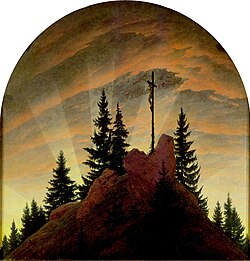Friedrich, Caspar David
Back

Image source
Wikimedia
https://en.wikipedia.org/wiki/File:Gerhard_von_K%C3%BCgelgen_portrait_of_Friedrich.jpg
Basic data
-
September 5, 1774 in Greifswald
-
†May 7, 1840 in Dresden
-
Maler, Zeichner
-
Dresden
Documents
Biographical information from the WeGA
No biographical data found
Biography not available due to one of the following causes:
- Data will be added at a later stage
- Research of the WeGA was without success so far
- It is a well known person where enough information is available online elsewhere, see e.g Wikipedia





![Chalk Cliffs on Rügen (1818). 90.5 × 71 cm. Museum Oskar Reinhart am Stadtgarten, Winterthur, Switzerland. Friedrich married Christiane Caroline Bommer in 1818, and on their honeymoon they visited relatives in Neubrandenburg and Greifswald. This painting celebrates the couple's union.[30] (Source: Wikimedia) Chalk Cliffs on Rügen (1818). 90.5 × 71 cm. Museum Oskar Reinhart am Stadtgarten, Winterthur, Switzerland. Friedrich married Christiane Caroline Bommer in 1818, and on their honeymoon they visited relatives in Neubrandenburg and Greifswald. This painting celebrates the couple's union.[30] (Source: Wikimedia)](https://upload.wikimedia.org/wikipedia/commons/thumb/a/a7/Caspar_David_Friedrich%27s_Chalk_Cliffs_on_R%C3%BCgen.jpg/250px-Caspar_David_Friedrich%27s_Chalk_Cliffs_on_R%C3%BCgen.jpg)


![The Abbey in the Oakwood (1808–1810). 110.4 × 171 cm. Alte Nationalgalerie, Berlin. Albert Boime writes, "Like a scene from a horror movie, it brings to bear on the subject all the Gothic clichés of the late eighteenth and early nineteenth centuries."[50] (Source: Wikimedia) The Abbey in the Oakwood (1808–1810). 110.4 × 171 cm. Alte Nationalgalerie, Berlin. Albert Boime writes, "Like a scene from a horror movie, it brings to bear on the subject all the Gothic clichés of the late eighteenth and early nineteenth centuries."[50] (Source: Wikimedia)](https://upload.wikimedia.org/wikipedia/commons/thumb/3/32/Caspar_David_Friedrich_-_Abtei_im_Eichwald_-_Google_Art_Project.jpg/250px-Caspar_David_Friedrich_-_Abtei_im_Eichwald_-_Google_Art_Project.jpg)
![The Sea of Ice (1823–1824), Kunsthalle Hamburg. This scene has been described as "a stunning composition of near and distant forms in an Arctic image".[55] (Source: Wikimedia) The Sea of Ice (1823–1824), Kunsthalle Hamburg. This scene has been described as "a stunning composition of near and distant forms in an Arctic image".[55] (Source: Wikimedia)](https://upload.wikimedia.org/wikipedia/commons/thumb/0/0c/Caspar_David_Friedrich_-_Das_Eismeer_-_Hamburger_Kunsthalle_-_02.jpg/250px-Caspar_David_Friedrich_-_Das_Eismeer_-_Hamburger_Kunsthalle_-_02.jpg)
![Man and Woman Contemplating the Moon (c. 1824). 34 × 44 cm. Alte Nationalgalerie, Berlin. A couple gaze longingly at nature. Dressed in "Old German" clothes, according to Robert Hughes, they are "scarcely different in tone or modelling from the deep dramas of nature around them".[59] (Source: Wikimedia) Man and Woman Contemplating the Moon (c. 1824). 34 × 44 cm. Alte Nationalgalerie, Berlin. A couple gaze longingly at nature. Dressed in "Old German" clothes, according to Robert Hughes, they are "scarcely different in tone or modelling from the deep dramas of nature around them".[59] (Source: Wikimedia)](https://upload.wikimedia.org/wikipedia/commons/thumb/3/3e/Caspar_David_Friedrich_-_Man_and_Woman_Contemplating_the_Moon_-_WGA08271.jpg/250px-Caspar_David_Friedrich_-_Man_and_Woman_Contemplating_the_Moon_-_WGA08271.jpg)



![Paul Nash, Totes Meer (Sea of the Dead), 1940–41. 101.6 x 152.4 cm. Tate Gallery. Nash's work depicts a graveyard of crashed German planes comparable to The Sea of Ice (above).[72] (Source: Wikimedia) Paul Nash, Totes Meer (Sea of the Dead), 1940–41. 101.6 x 152.4 cm. Tate Gallery. Nash's work depicts a graveyard of crashed German planes comparable to The Sea of Ice (above).[72] (Source: Wikimedia)](https://upload.wikimedia.org/wikipedia/commons/thumb/9/9a/Totes_Meer_%28Dead_Sea%29_1940-1_Paul_Nash.jpg/250px-Totes_Meer_%28Dead_Sea%29_1940-1_Paul_Nash.jpg)






